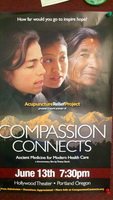Kimberly "Kimo" Shotz, LAc, WHCNP, RN

Aloha.
I am a board-certified Licensed Acupuncturist and Chinese Herbalist and Women's Healthcare Nurse Practitioner (NP) living and practicing on Portland's east side.
I have worked as an operating room (OR) Registered Nurse for 11 years and continue to practice as a Nurse Practitioner since 1997 (OBGYN and UROGYN).
In 2011 I added East Asian Medicine to my healer’s tool-belt with a Master's Degree in Acupuncture and Oriental Medicine from Oregon College of Oriental Medicine in Portland, Oregon.
I firmly believe integrative medicine is essential for effective medicine, for achieving faster, sustainable healing and overall better health. My unique background in both East Asian and conventional medicine serves to strengthen my insight and ability to treat a vast variety of conditions and to collaborate with other practitioners involved in my patients’ healthcare.
I welcome all patients and encourage everyone to actively participate in his/her/their healing process.
In my spare time I am cultivating my own health by exploring the Pacific Northwest with my family and friends, tending to my veggie gardens, playing music, and grazing my way through the scrumptiously diverse Portland-area cuisine. What a rich and nourishing city we live in. Viva Portlandia!
I am a board-certified Licensed Acupuncturist and Chinese Herbalist and Women's Healthcare Nurse Practitioner (NP) living and practicing on Portland's east side.
I have worked as an operating room (OR) Registered Nurse for 11 years and continue to practice as a Nurse Practitioner since 1997 (OBGYN and UROGYN).
In 2011 I added East Asian Medicine to my healer’s tool-belt with a Master's Degree in Acupuncture and Oriental Medicine from Oregon College of Oriental Medicine in Portland, Oregon.
I firmly believe integrative medicine is essential for effective medicine, for achieving faster, sustainable healing and overall better health. My unique background in both East Asian and conventional medicine serves to strengthen my insight and ability to treat a vast variety of conditions and to collaborate with other practitioners involved in my patients’ healthcare.
I welcome all patients and encourage everyone to actively participate in his/her/their healing process.
In my spare time I am cultivating my own health by exploring the Pacific Northwest with my family and friends, tending to my veggie gardens, playing music, and grazing my way through the scrumptiously diverse Portland-area cuisine. What a rich and nourishing city we live in. Viva Portlandia!
Acupuncture Relief Project, Chapagoan, Nepal

I had the very special opportunity to return to Nepal in Winter 2011 as a member of this amazing volunteer practitioner team in Chapagoan, Nepal. This experience was a treasure I documented well on my cameras. Alas, my Buddhist lesson in impermanence, relinquishing material possessions and letting go came when I lost both my camera and video camera the week before I left Nepal. Serendipitously, I was involved in this beautiful, award-winning documentary by Tristan Koch, so there is proof I was there!
Please check out the ARP website blogs and the documentary. Thanks ARP team and Tristan!
www.acupuncturereliefproject.org
Please check out the ARP website blogs and the documentary. Thanks ARP team and Tristan!
www.acupuncturereliefproject.org
Education
- Oregon College of Oriental Medicine Class of 2011---Master of Acupuncture and Oriental Medicine
- Oregon Health Sciences University School of Nursing Class of 1997--Master of Nursing, Women's Healthcare
- University of Vermont School of Professional Nursing Class of 1989--Bachelor of Nursing
Certifications/Licenses
- National Certification Commission for Acupuncture and Oriental Medicine - #138491
- Oregon Medical Board. Licensed Acupuncturist - #AC156829
- Oregon State Board of Nursing. Women’s Health Care Nurse Practitioner - #093006979N7
- National Certification Commission: Women's Healthcare Nurse Practitioner #104252556
- Clean Needle Technique, Council of Colleges of Acupuncture and Oriental Medicine 10/09
- Advanced Cardiac Life Support/Basic Life Support, CPR/AED/First Aid certified
Acupuncture Treatment Styles That I Use
Channel/Organ (Yin-Yang). Technique uses select acupuncture points from anywhere on the body (front back, top, bottom) to stimulate and move Qi and Blood, free-up stuck-ness, restore balance, nourish the body, calm the mind.
Trigger-point/Muscle motor point. Uses for musculo-skeletal pain and restricted movement by stimulating the pesky muscle fibers directly.
Kiiko Matsumoto Style. So simple yet oh, so complex! Few gentle, painless needles and rice cone moxa. Searches the body for instant feedback on which specific areas need attention and how to effectively treat them. Does not require much discussion. Can have profound results.
Mukaino M-Test: No needles. Another style from Japan that is gentle, simple, minimalistic yet impressively effective, in the Japanese tradition.
Dr. Tan's Balance Method. A minimalist technique with a powerful effect. Typically fewer needles placed away from the affected area/s (avoids placing needles into the painful spots).
Auricular (Ear) Acupuncture. Thin, tiny temporary needles or small radish seeds taped in place on the ears that correspond to body parts, organs, the nervous system, and more.
Scalp acupuncture. Uses points on the entire scalp that correspond to regions and functions of the body.
Trigger-point/Muscle motor point. Uses for musculo-skeletal pain and restricted movement by stimulating the pesky muscle fibers directly.
Kiiko Matsumoto Style. So simple yet oh, so complex! Few gentle, painless needles and rice cone moxa. Searches the body for instant feedback on which specific areas need attention and how to effectively treat them. Does not require much discussion. Can have profound results.
Mukaino M-Test: No needles. Another style from Japan that is gentle, simple, minimalistic yet impressively effective, in the Japanese tradition.
Dr. Tan's Balance Method. A minimalist technique with a powerful effect. Typically fewer needles placed away from the affected area/s (avoids placing needles into the painful spots).
Auricular (Ear) Acupuncture. Thin, tiny temporary needles or small radish seeds taped in place on the ears that correspond to body parts, organs, the nervous system, and more.
Scalp acupuncture. Uses points on the entire scalp that correspond to regions and functions of the body.
